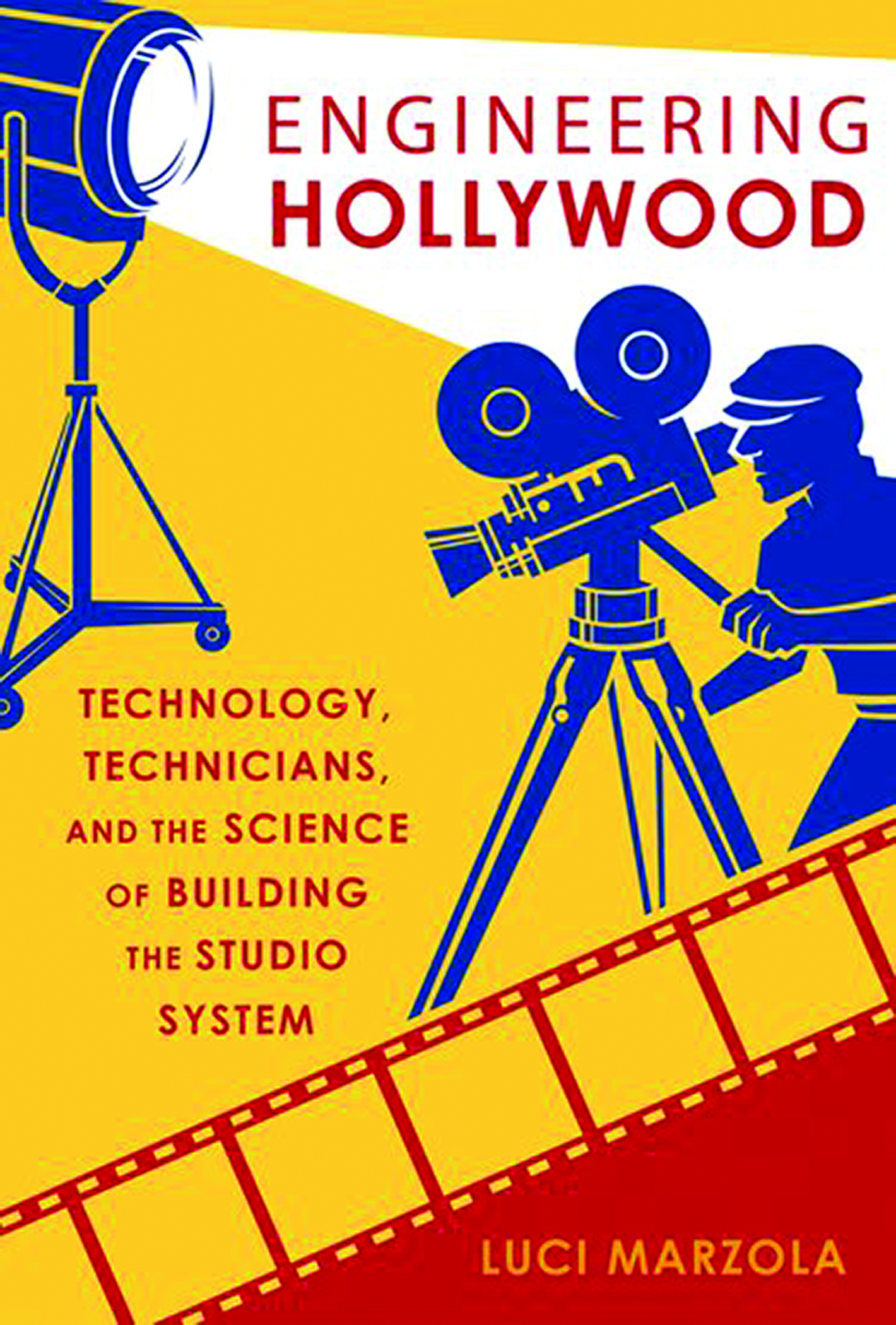Whereas studio moguls, producers, and directors have generally received credit for the classical Hollywood studio system’s genius, in her new book, Engineering Hollywood, Luci Marzola recenters our understanding of the early studio system around the vital but frequently ignored contributions and collaborations of motion picture engineers, specified as “the hundreds of engineers and companies that produced and processed the most essential aspects of motion picture production.”2 This recentering requires us to rethink the industrial model of the classical Hollywood studio system, which Marzola argues is “fundamentally built on the sharing of technological knowledge.”3 Erected on a literary foundation of industry, technology, and labor, this production study identifies professional trade organizations as structures of power in early Hollywood, exploring their horizontal integration, “work[ing] to create a unified system built around largely standardized technology.”4 Marzola draws technological and industrial research from scholars such as David E. Noble, Lewis Mumford, Carroll Pursell, Antoine Picon, and Lyn Spillman, in addition to traditional classical Hollywood studio system scholars, such as David Bordwell, Kristin Thompson, Donald Crafton, Janet Staiger, and Thomas Schatz.
Marzola’s engagement with scholarly research at the intersection of industry and technology not specific to motion picture production allows her to identify how Hollywood both aligned with and deviated from industrial production standards of the era. For instance, Marzola argues that despite publicizing itself as a “dream factory” and using the discursive rhetoric of manufacturing plants with descriptions of its “assembly line production,” the motion picture studios still largely consisted of “self-trained craftsmen” using “artisanal methods.”5 Before the Hollywood studio system could evolve into the industrialized model of peak production and specialization, technological standardization for the purposes of both consistent quality and uniform infrastructure was crucial. Marzola asserts that “the innovators and maintainers of technology” needed to professionalize their segment of the industry, thus necessitating the formation of trade organizations that would “create a unified identity, built around specialized skills and knowledge.”6
For these trade organizations, such as the Academy of Motion Picture Arts and Sciences (AMPAS), American Society of Cinematographers (ASC), and Society of Motion Picture Engineers (SMPE), collaboration had to take precedence over competition, at least with respect to the primary goal of standardization, even though fellow members worked for rival studios and firms. Marzola traces the history of these organizations’ formation, evolution, and eventual collaboration through extensive primary research of archival materials from the relevant trade organizations, corporations, firms, and trade publications. Some of the trade publications were produced by the organizations themselves in order to promote their craft and spread institutional knowledge to their members. Marzola adeptly navigates the potentially unruly alphabet soup of organizational acronyms to weave a fascinatingly detailed argument for “looking at Hollywood motion picture production as a technology business, rather than an anomalous industry,” which she contends “can place the studio system within its proper historical context of the American economy and culture as a whole.”7
Marzola divides Engineering Hollywood into two sections, the first of which looks at the formation, growth, and spread of particular spheres of technological control in the motion picture industry, specifically technology manufacturers, independent service firms, and studio technicians. Chapter 1 introduces the reader to the SMPE, which represented the technology manufacturers and engineers located on the East Coast, and their quest for industrial standardization of technological equipment and technical practices, as they continued to tailor their products for use in motion picture production. While these manufacturers’ products consisted of items essential to film production, such as film stock, lenses, and lighting equipment, Marzola reminds us that all three of these items were also widely used outside of the motion picture industry, and thus specializing the technology was required to sell to motion picture producers. Rather than exerting solely their own efforts to build the infrastructure and absorbing the inherent costs, manufacturers hoped joining forces within the SMPE would spread the responsibility to both specialize the equipment for motion picture production and standardize its application. Marzola notes this collaborative spirit started off rockily for some. In the wake of World War I, as shortages and rationing affected the supply chain, large manufacturers and small engineering firms alike saw both the need and opportunity to step in and gain market share. In this environment, a newcomer to film stock like Dupont was able to successfully challenge the goliath Kodak for market share through targeted customer service aimed at Hollywood cinematographers and technicians.
Despite this progress toward selling technology to Hollywood, the geographical barrier between the East Coast manufacturers and West Coast motion picture studios posed some logistical hurdles, which, according to Marzola, created opportunities for the smaller engineering firms located in relatively close proximity to the Hollywood studios. These smaller firms are the subject of Chapter 2. As Hollywood evolved from what Marzola labels a “manufacturing outpost” into an “integrated economic, industrial zone,” the establishment of new service firms and the relocation of existing firms formed a “technological service sector” that specialized in serving the Hollywood studios and production companies.8 Independent film processing laboratories were the first domino to fall, as transporting film to be processed back and forth across the country was cumbersome, time-consuming, and costly. In addition to the constraints, studio technicians also saw the increasing importance of film processing to cinematography and increasingly hoped to incorporate it into their purview. As more sectors followed, Hollywood developed a “permanent service infrastructure” and a “service corridor” that established the area as a “central hub for technological service firms,” a distinction that Marzola points out Hollywood retains to this day.9
Chapter 3 reveals how technicians were able to accumulate social and cultural capital to position themselves within the studio system, raising their stature in the industry and forming an exchange of institutional technological knowledge. Obtaining this knowledge provided technicians with industrial clout, as they traversed apprenticeship and hierarchical progression through departmental ranks. According to Marzola, this also created a gatekeeping mechanism in which technicians such as cinematographers “maintain[ed] authority over those who entered the profession, thereby controlling a key element of the production process away from both the studios and the unions.”10 The cinematographers enforced this gatekeeping through their trade organization, ASC, “keeping aspirants out of the profession [rather] than bringing new blood into the ranks.”11 By limiting who could become a new member, the ASC also ensured their existing members and their trade were promoted in the pages of their monthly publication, American Cinematographer. This publication served an additional important purpose, spreading production and technological knowledge to its readers. Enriching the technological knowledge of its members, while also promoting their cinematic artistry, afforded the ASC’s cinematographers with a “perceived irreplaceability” within the industry.12
The second section of Engineering Hollywood demonstrates how these trade organizations formed a collaborative framework to oversee, regulate, and standardize the motion picture industry’s technology. Chapter 4 highlights the organized industrial experiments with incandescent lighting in 1928 (later known as the Mazda tests) and how these experiments “set precedents that would profoundly affect how technology would be dealt with in Hollywood for decades to come.”13 Chapter 5 demonstrates how these precedents expanded through the introduction, adoption, and evolution of synchronized sound. Through collaboration, negotiation, and positioning for influence, the SMPE, ASC, and AMPAS established their parts in the process of technological management, a control of knowledge that Marzola argues “would become the currency by which the various trade associations and the powers behind them asserted their place within the system.”14
Finally, Chapter 6 covers how the technological management infrastructure consolidated, relying on the SMPE and AMPAS as “the major forces of research and standardization,” and how knowledge circulation expanded with additional technical journals and technological publications.15 Marzola concludes that this solidification stabilized the management of motion picture technology for the next two decades of the classical Hollywood era until suburbanization, divestment of the studios’ exhibition chains, and competition from television all contributed to the end of the studio system’s golden age.
Engineering Hollywood is boldly conceived, brilliantly executed, and endlessly generative to how future production and technology studies examine social and cultural capital not only within the classical Hollywood studio system but conceivably within other industrial labor sectors. The accumulation of industrial clout and institutional knowledge is the accumulation of power and therefore an incredibly important area of focus for future research. Marzola’s recentering of the studio system as a technological industry is crucial to understanding its stability and longevity. Without this exchange of technological knowledge, Marzola asserts, it is unlikely that the industry’s stabilization would have occurred, thus reinforcing the importance of understanding the motion picture industry’s management of technology as “a central tenet of the studio system alongside such concepts as the central producer system, vertical integration, and the star system.”16 As current scholars examine the extent to which the present-day motion picture industry is being influenced and transformed by Big Tech, Marzola astutely points out that for Hollywood, history is simply repeating itself.
Notes
- Casey Walker is a PhD student in the Department of Radio-Television-Film at The University of Texas at Austin. His research currently focuses on cinematographic labor in the Hollywood studio system, exploring how studio camera departments, trade organizations, World War II photography units, and early television production crews served as exchanges for cultural capital during the studios’ era of dominance. He also examines how these groups, their departmental heads, and their specialized technicians accumulated social capital while reinforcing the homogenization of these technical departments and organizations. ⮭
- Luci Marzola (2021), Engineering Hollywood: Technology, technicians, and the science of building the studio system (p. 2). Oxford: Oxford University Press. ⮭
- Ibid., 2. ⮭
- Ibid., 6. ⮭
- Ibid., 7. ⮭
- Ibid., 8 & 10. ⮭
- Ibid., 12. ⮭
- Ibid., 44. ⮭
- Ibid., 56–58. ⮭
- Ibid., 83. ⮭
- Ibid., 84. ⮭
- Ibid., 100. ⮭
- Ibid., 134. ⮭
- Ibid., 163. ⮭
- Ibid., 165. ⮭
- Ibid., 197. ⮭



